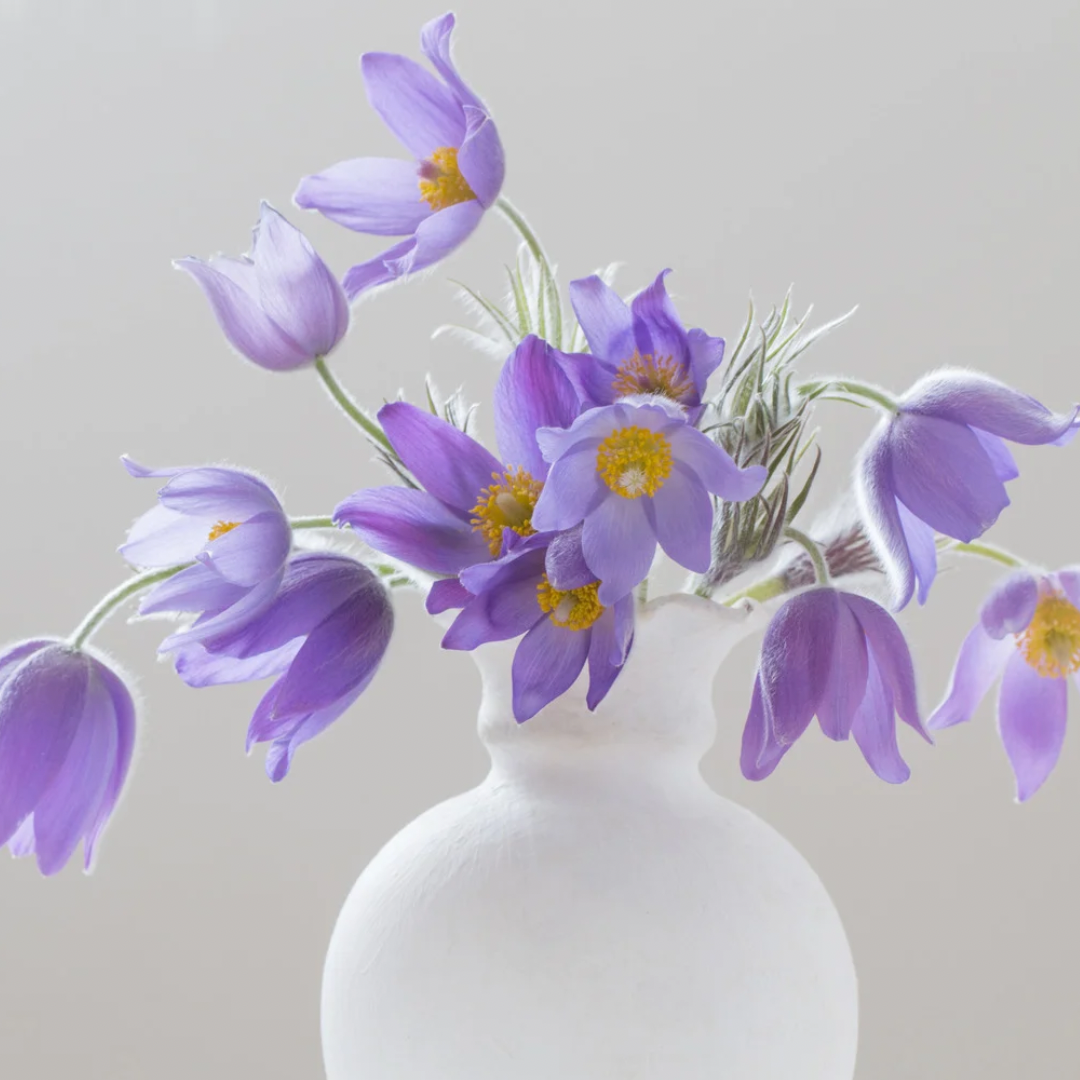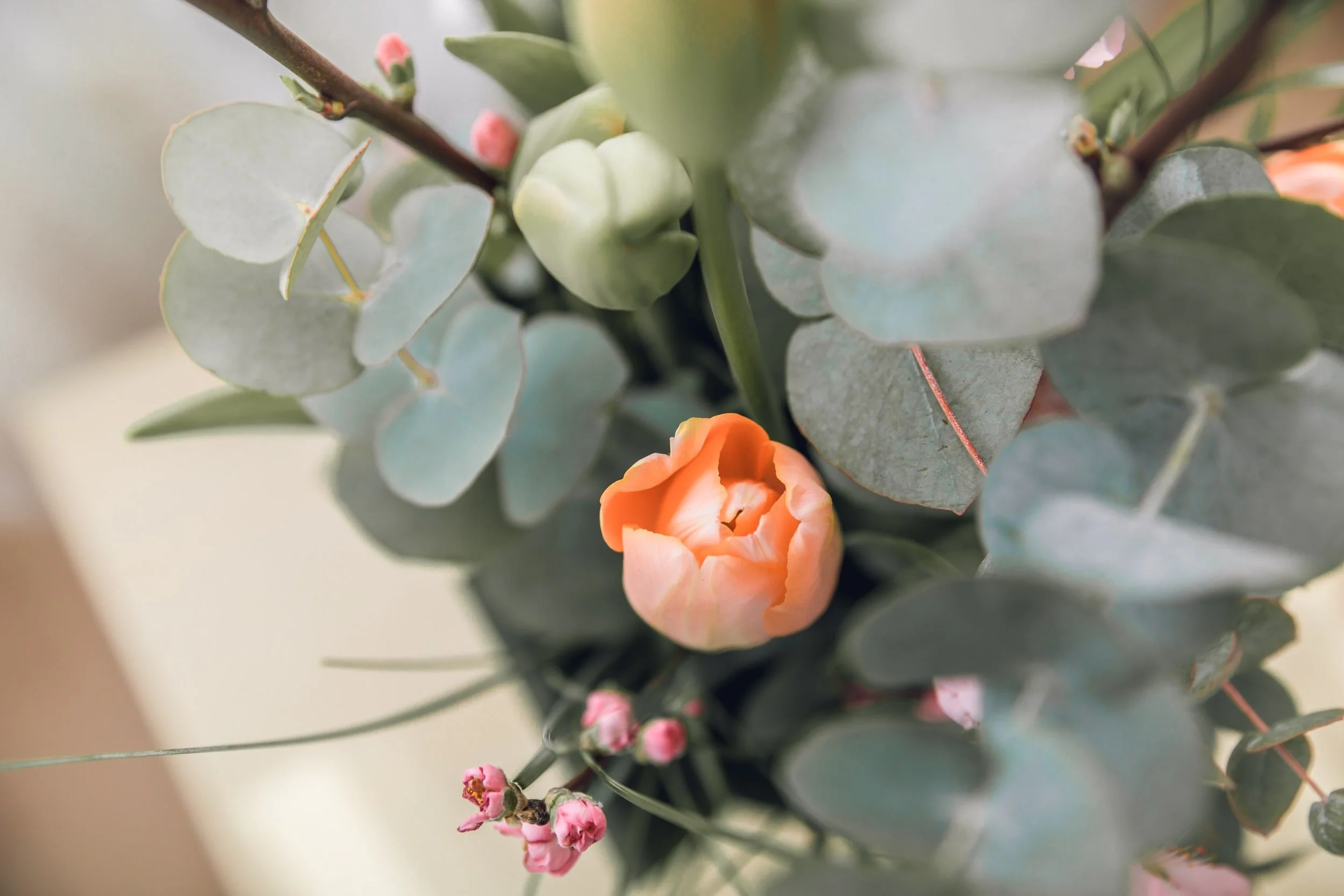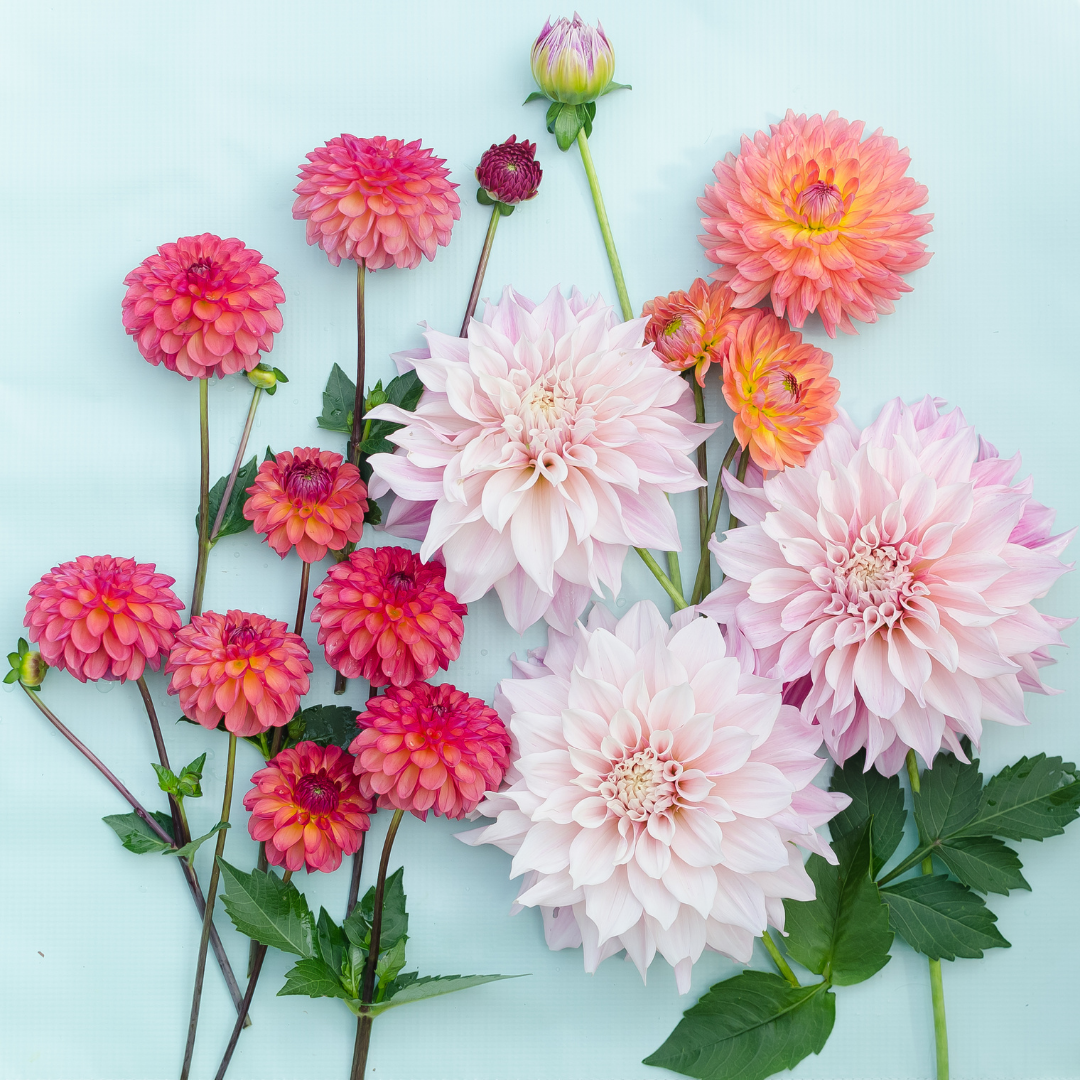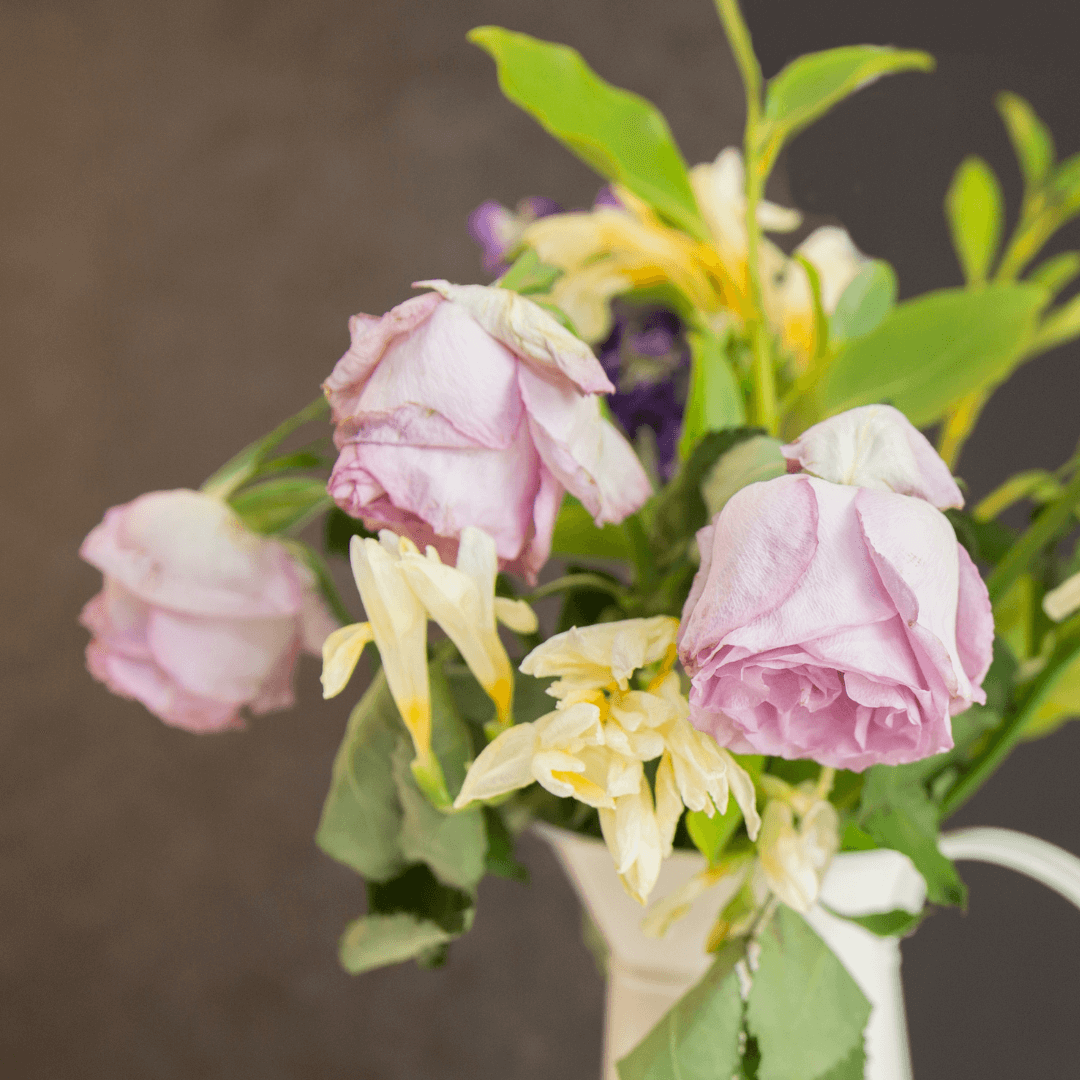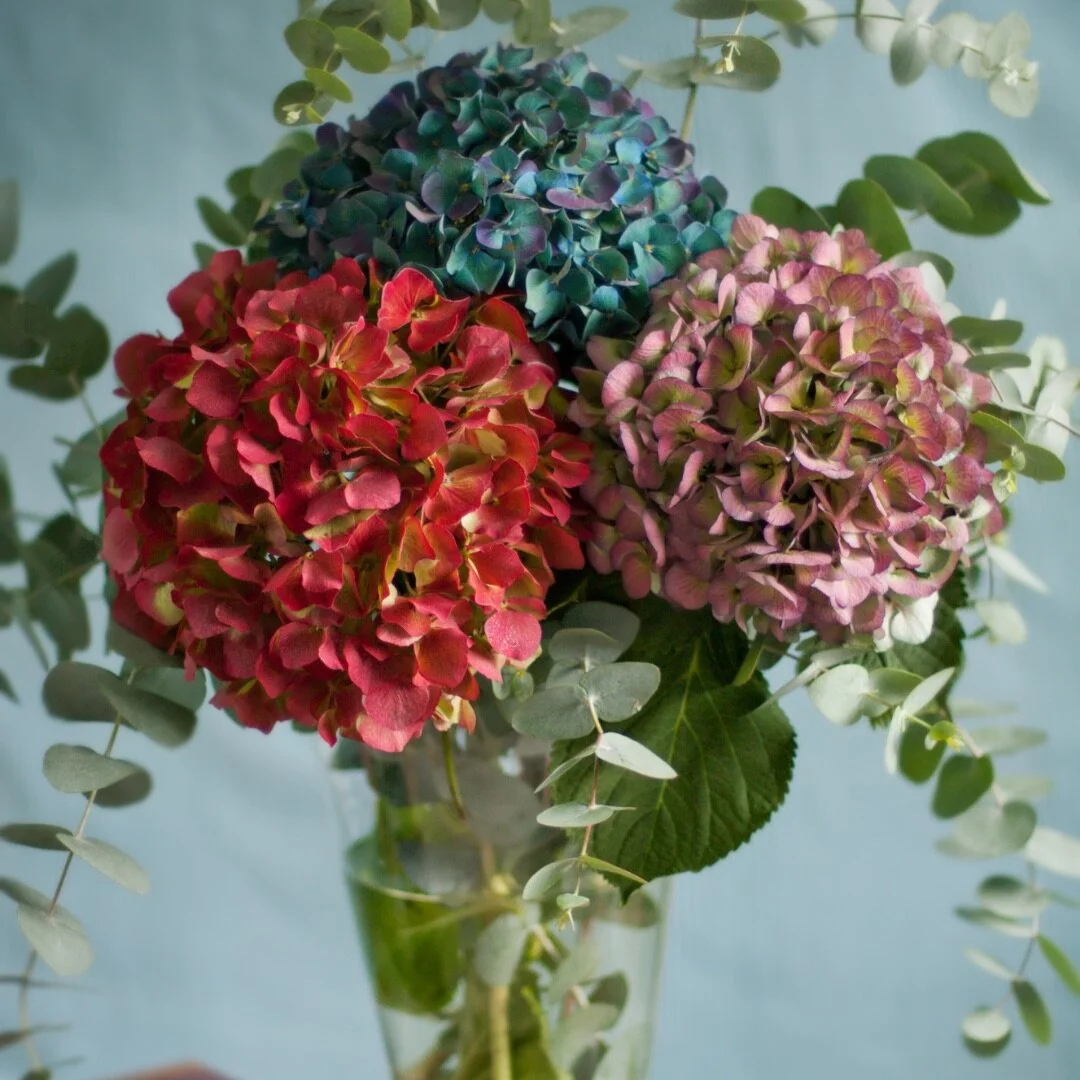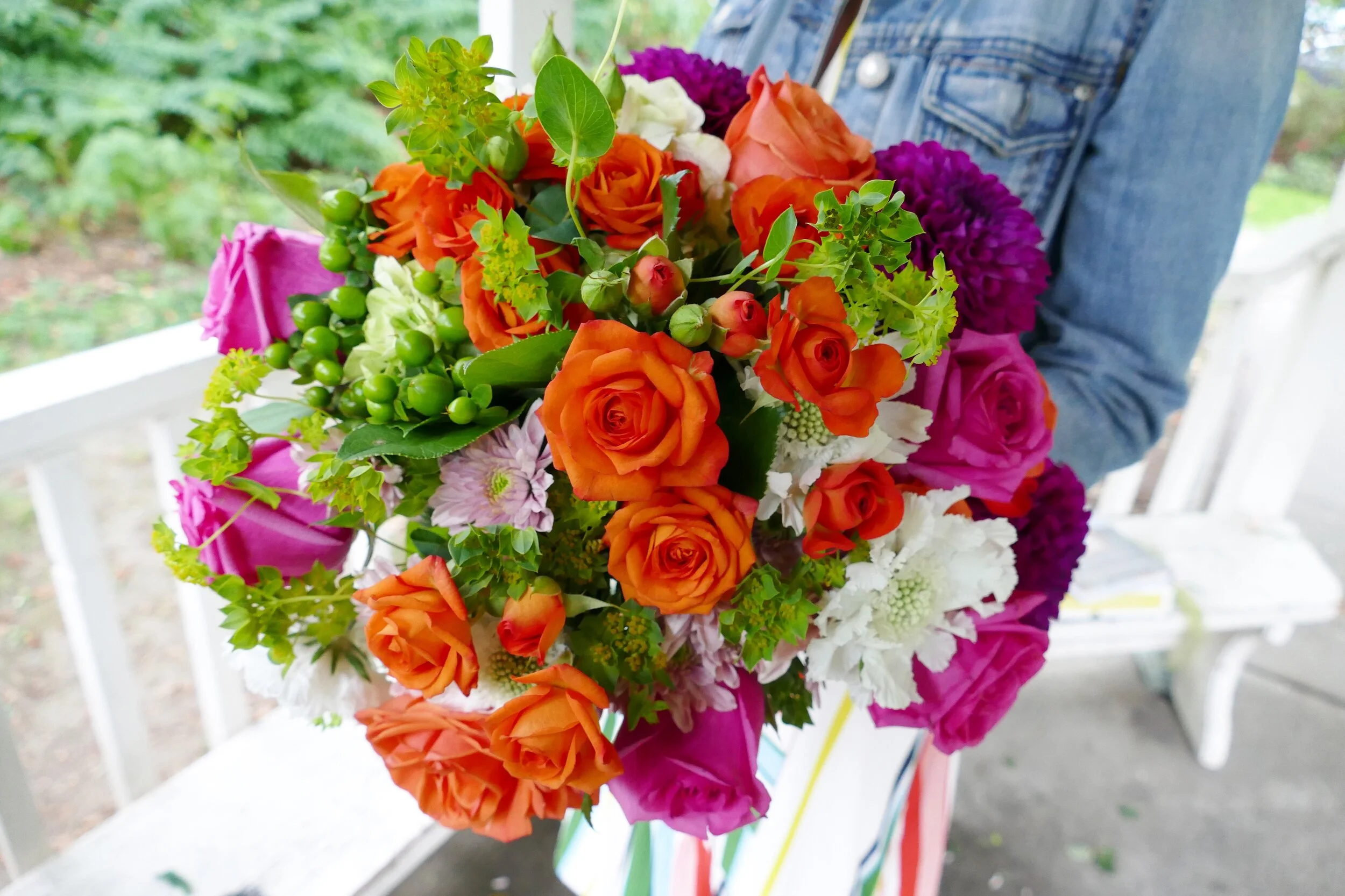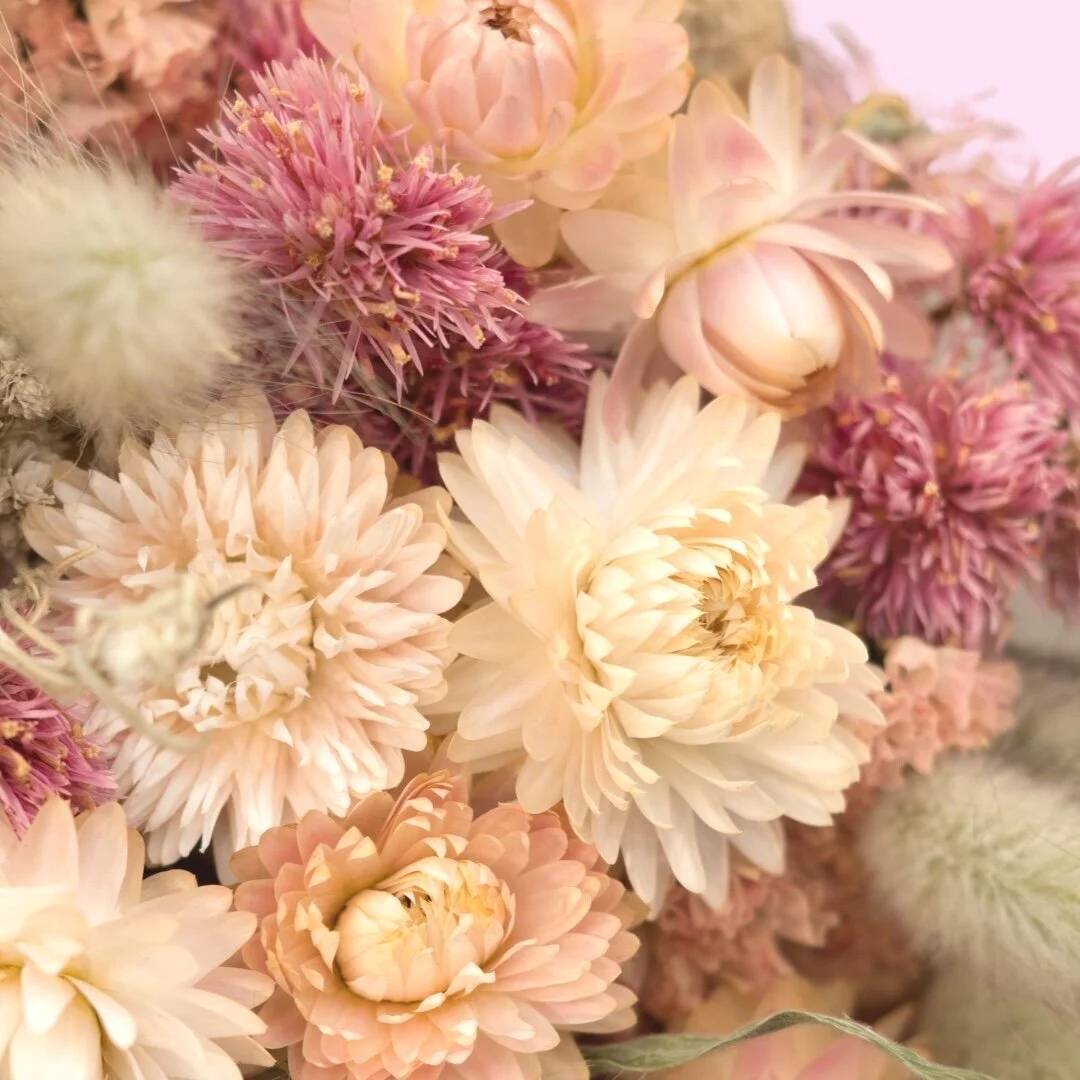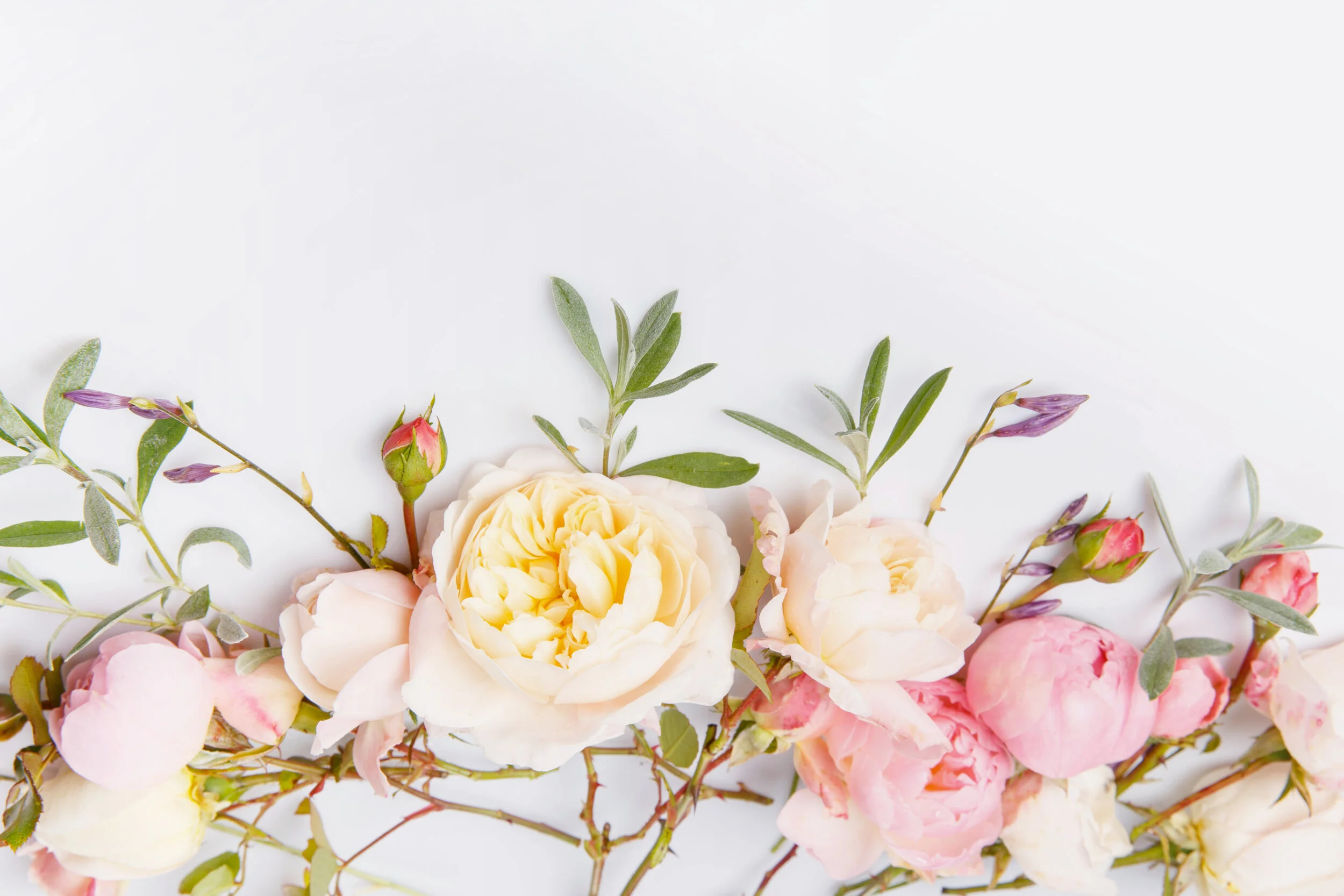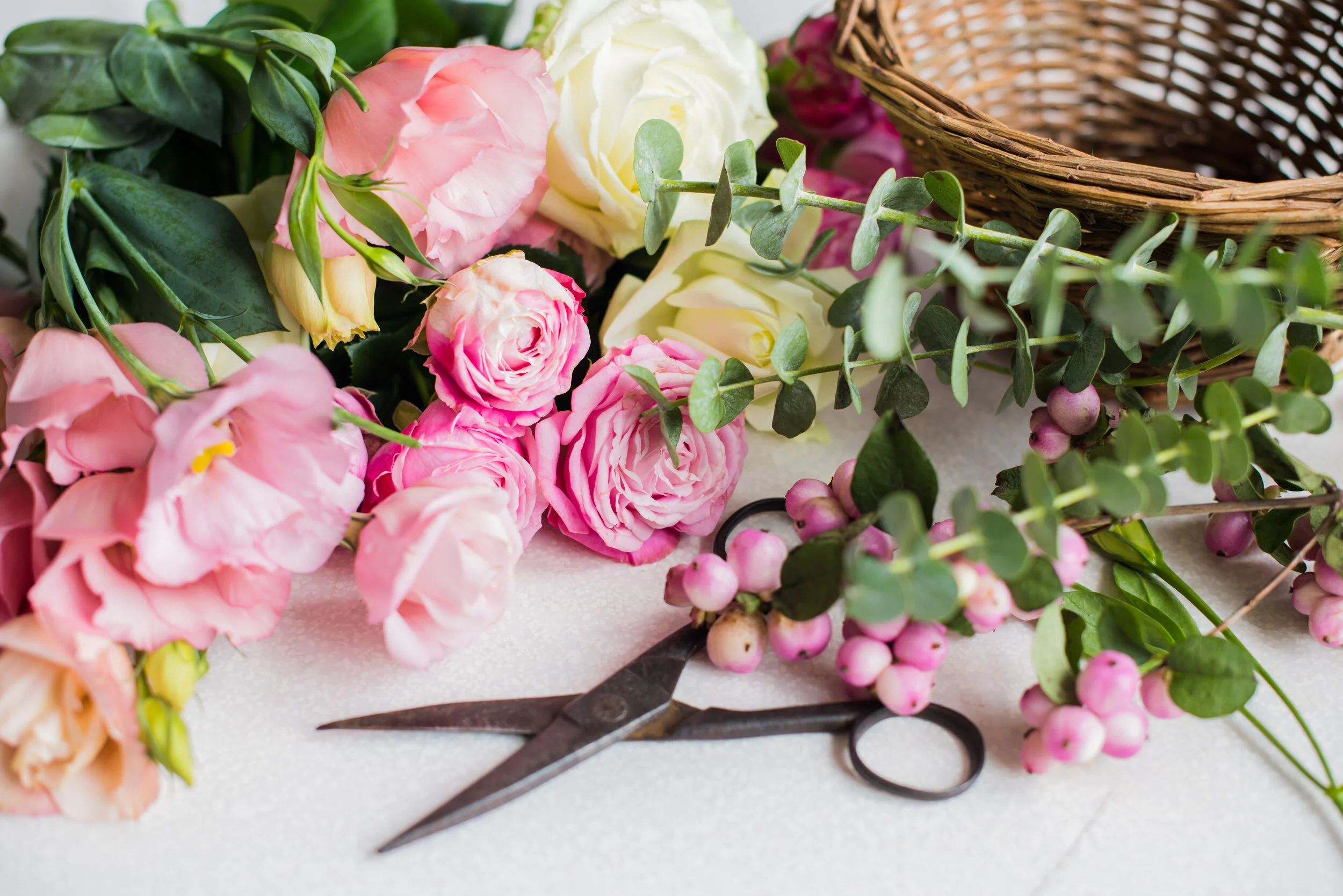4 Tips on how to Arrange Short-stemmed Flowers in a Tall Vase
My most popular blog post ever was ‘How to Arrange Short-stemmed Flowers in a Tall Vase’. Since that was a while ago I thought I would share my suggestions again.
Here’s what you can do when you have …
My most popular blog post ever was ‘How to Arrange Short-stemmed Flowers in a Tall Vase’. Since that was a while ago I thought I would share my suggestions again.
Here’s what you can do when you have a vase that is too tall for your short-stemmed flowers:
Tape a grid: Take some scotch tape and tape a criss-cross grid along the top of your vase. Make sure the holes you create are quite small. You want the stem of a flower to fit through the opening, but not slip all the way down. If the stems are very thin, you could put a few together into the same space. Make sure you keep the water level topped up using this technique as the stems won’t be reaching very far down into the vase.
Rule of thirds with a flower arrangement: In floral arranging, there’s the ‘rule of thirds’; the vase or container should be ⅓ of the total height of the arrangement and the flowers should be ⅔’s. This will create a balanced look. But, you can also do a ‘reversed rule of thirds’, so the flowers are ⅓ of the total height of the arrangement and the vase is ⅔’s. This is definitely a different look and may take you a bit of getting used to, but it will create a balanced looking arrangement.
Attach to a long-stemmed flower or piece of foliage: A little trick you can do is take some floral tape, or a piece of twine, and attach your short-stemmed flower, to the longer stem of a flower or piece of foliage. The longer stem will go to the bottom of the vase while giving the flower some height. With this technique, once again you need to keep your vase filled almost to the brim with water, to make sure the tip of the short-stemmed flower is always in water.
The upside-down container: Find a container in your kitchen that’s a bit narrower than your vase and about ½ to ⅔ the height. Turn it upside down in the vase and then fill the vase with water. The bottom of the container makes a false bottom in the vase. Your short stems will be able to rest on it giving them the needed height.
I hope these tips help. Let me know if you try any and how they work for you. And if you have any other tips, please share with us in the comments below.
My Top Money Saving Tip For Having Flowers In Your Home
Today I am looking back at a post I wrote about a year ago, because as winter is upon us and the days become shorter and darker, it’s more important than ever to find ways to add beauty and brightness to our lives.
A great way to do this is with flowers - and it doesn’t have to be expensive. A great money-saving tip is …
Today I am looking back at a post I wrote about a year ago, because as winter is upon us and the days become shorter and darker, it’s more important than ever to find ways to add beauty and brightness to our lives.
A great way to do this is with flowers - and it doesn’t have to be expensive. A great money-saving tip is to use long-lasting greenery along with the flowers in your bouquets and arrangements. If treated correctly the greenery can be reused for weeks, so all you need to do is replace the flowers.
In this post I’ll be sharing with you: the important role greenery plays in flower arrangements, tips on properly caring for greenery, suggestions for hardy greenery that has a long vase life, and ten suggestions for winter greenery.
Five ways greenery plays an important role in a flower arrangement:
1 - Provides a backdrop to highlight the flowers.
2 - Adds a rich texture.
3 - Fills space to create a fuller look.
4 - Acts as an armature to hold the flower stems in place.
5 - Creates a more ‘garden-esque’ look.
Six tips on how to properly care for greenery:
1 - Use mature growth. New growth has not had time to get robust and won’t last as long.
2 - Make sure your vases are clean and have fresh water.
3 - Clean the stems so any leaves that would be below the waterline are removed.
4 - Cut the stems at an angle so they have the largest surface for absorbing water.
5 - Keep out of direct heat sources and away from open flames.
6 - Replace the water and recut the stems every two days.
Top tip:
You may have heard that it’s a good idea to bash stems that are ‘wooden’. I suggest you don’t. Bashing them prevents the water from flowing freely up the stem.
Four long-lasting greenery suggestions that are available all year long:
1 - Eucalyptus
2 - Salal
3 - Ivy
4 - Ruscus
Ten suggestions for winter greens:
1 - Noble fir
2 - Holly
3 - Rosemary
4 - Cedar
5 - Hemlock
6 - Pine
7 - Magnolia
8 - Blue spruce
9 - Juniper
10 - Carolina Sapphire
To note:
The fragrance of winter greens will instantly make your home feel cozy and put you in the holiday spirit. As with all greens, treat them properly to give them the longest vase life possible.
Final words:
The colour green symbolizes life, renewal, energy, growth, harmony, and good fortune. You can find out more about specifically green flowers in my blog post, ‘Yes, There are Green Flowers’.
Dahlias - Easy Care Tips to Lengthen Their Vase Life
It’s dahlia season! These vibrant beauties are abundant during August, September, and even into October. They come in a wide variety of shapes, sizes and colours making them a favourite flower choice to use in bouquets and arrangement. While known for having a relatively short vase life (3-4 days), there are easy things you can do to make them last longer.
It’s dahlia season! These vibrant beauties are abundant during August, September, and even into October. They come in a wide variety of shapes, sizes and colours making them a favourite flower choice to use in bouquets and arrangements. While known for having a relatively short vase life (3-4 days), there are easy things you can do to make them last longer.
Follow these steps and you’re sure to find success:
1 - Fill a vase with warm water. Dahlia stems are hollow, so getting water into them quickly is very important. Warm water will flow into the stems faster than cool water, and that in turn will prolong the dahlias' vase-life.
2 - Clean all the leaves off the stem that would sit below the water line. Then, holding the stem under the water, use a sharp knife to cut about 1 inch off the bottom. If you cut the stem at an angle it will give a larger surface area from which to absorb water.
3 - As much as you can, keep your vase of dahlias in a cool place. This means away from direct sunlight, heating vents and any warm appliances. If you’ll be using them as a centrepiece for a dinner party or event, keep them in a cool room for as long as possible before placing them on display.
4 - Change the water every day. Fresh, clean water will make a huge difference in how long your dahlias will last.
5 - Dahlias can be a bit top heavy. They seem to last a bit better if the flower bloom is supported by other blooms. Experiment a bit when arranging them and see what you think works best.
Follow these tips and you’re sure to enjoy your spectacular dahlia blooms for days on end. Now I’m off to buy some dahlias …
Of special note: As mentioned, dahlias come in a variety of shapes and sizes, and not all varieties will last the same amount of time. Tighter, more compact varieties like ‘pom-pom dahlias’, will last longer than the big ‘dinner plate’ varieties like ‘café au lait’.
PS: In the language of flowers dahlias have the meanings of dignity and elegance.
How To Tell If The Flowers You're Buying Are Fresh
Have you ever bought a bunch of flowers, taken them home, popped them into a vase and the next day they look sad and wilted? It’s so disappointing. And while no-one expects flowers to be ever-lasting, they should stay looking fresh and healthy for several days - or even weeks.
Have you ever bought a bunch of flowers, taken them home, popped them into a vase and the next day they look sad and wilted? It’s so disappointing. And while no-one expects flowers to be ever-lasting, they should stay looking fresh and healthy for several days - or even weeks.
One of the most important things you can do to make sure your flowers have the longest vase life possible is to get in the habit of inspecting flowers before you buy them. You’ll soon learn to choose only those that are the freshest. Here’s what you’re looking for:
Buds:
The buds should be in the beginning stage of opening. (If the buds are tightly closed, it’s possible they’ve been harvested too soon and may never open.)
Gently feel the petals and make sure there is a firmness to them - you don’t want them to be limp.
The colours should be bright - not transparent.
Roses - Check the underside of the bud. If a few petals have been removed, that’s okay. Those were just the guard petals that protected the rose during transport, but if many petals have been removed that indicates someone is trying to hide the fact the flower is old.
Tulips - Most tulips we buy seem to come in a cellophane sleeve. A good indication the tulips are old is if they have grown above the top edge of it.
Leaves:
Check the leaves are bright coloured with no yellowing or browning. The leaves should be firm (not limp) and definitely not falling off the stem as soon as you pick the flowers up.
Stems:
Again colour and firmness are the most important things to look for. If the stem is limp and/or discoloured that flower won’t last much longer.
Fragrance:
Not all flowers are scented, but fragrance is still important to check. An old flower will smell of decay and should definitely be avoided.
Water:
If possible - check the bucket of water the flowers are being stored in. If it’s cloudy, dirty, or has leaves floating in it, skip those flowers. They’re sitting in bacteria and that will shorten their lifespan.
Being an educated shopper is the first step in making sure your flowers will last as long as possible. The second step is correct care once you get them home. Check out these previous blog posts to learn more:
How to Make Your Flowers Last Longer
Secrets Revealed - Top Tips for Making ‘Tricky’ Flowers Last Longer
Secrets Revealed - Top Tips to Make ‘Tricky’ Flowers Last Longer.
A vase of fresh flowers brightens up any room, but to keep them looking their best they need to be cared for properly. While all flowers require some level of basic care, there are some ‘tricky’ flowers that need a little extra TLC. While this requires a bit more effort on your part, the …
A vase of fresh flowers brightens up any room, but to keep them looking their best they need to be cared for properly. While all flowers require some level of basic care, there are some ‘tricky’ flowers that need a little extra TLC. While this requires a bit more effort on your part, the payoff is worth it.
There are two main things to look at - the bloom and the stem.
Tricky Blooms
Hydrangeas:
Hydrangeas are known for wilting quickly. What’s not as well known is that hydrangeas absorb water through their petals.
If your hydrangea is looking tired, fill a bucket or sink with water. Submerge the whole hydrangea head in the water for 30-60 minutes to rehydrate.
Note: This is only if your hydrangea has wilted prematurely. This will not revive a bloom that is dead.
Lilies:
As lilies bloom they reveal stamens of pollen in their centre. Removing the stamens will lengthen their vase life.
Bonus: Lily pollen stains anything it touches. Removing it will save you from having to deal with a stain on your clothes later on.
Roses:
When you first get your roses, if the outer petals seem wilted and a bit black around the edge, don’t worry. Growers leave these petals on to protect the inner part of the rose during travel. Just remove the outer layer of petals to allow the rose to bloom.
Note: When you buy your roses check the base of the bloom. If one layer has been removed, no problem, that was the guard petals. If many layers have been removed, don’t buy. If someone has removed multiple layers they’re trying to hide the fact the rose is old.
Tulips:
You bring some tulips home, put them in a vase and they’re standing straight and tall. The next morning the stems are curving and bending. What went wrong? Actually nothing. There are two scientific reasons why this happens. One, tulips continue to grow after they are cut and two, they’re attracted to light, so they’ll reach in that direction.
If you want your tulips to be straight, use a tall vase to give the stems extra support and turn the vase a quarter rotation daily.
Note: Or, you could just embrace the tulips movement and enjoy the uniqueness this flower has to offer.
Tricky Stems
Woody stems:
Woody stemmed flowers: Hydrangea, roses, lilac, heather, pussy willow
You may have heard you should smash the end of woody stems in order to help them absorb water. This is actually the wrong thing to do. Smashing the stems will increase the amount of bacteria in the water and shorten the vase life of the flower.
Instead, after cutting the end of the stem at a 45-degree angle, create an additional 2 inch cut up through the length of the stem.
Hollow stems:
Hollow stemmed flowers: Bells-of-Ireland, amaryllis, delphinium, lupins
The trick to getting hollow stemmed flowers to last longer is to fill the stem with water.
Remove any foliage off the stem; Cut the end at a 45-degree angle; turn stem upside down under a running tap to fill with water; hold thumb over the stem until it’s placed in a vase of water. The flower now has a whole stem full of water to drink from.
“Sap’ dripping stems:
Sap dripping flowers: Daffodils, tweedia, poinsettias
When you cut the stems of these flowers, a milky sap seeps out. This sap in the water clogs other flowers from absorbing water. There are two methods you can use to prevent this from happening. 1 - Cut the stem and immediately dip it in boiling water for 30 seconds; 2 - Light a candle and hold the end of the flower stem in the flame for a few seconds. Both will seal the end of the stem so they can then be placed into the vase of water.
If you follow these tips you’ll have ensured your flowers are in the best possible condition to give them the maximum amount of vase-life possible.
If you know of any other ‘secret’ tips, you’d like to share, please put them in the comments below.
How to Make Your Flowers Last Longer
The new year is a great time to start a healthy habit. This year I’m encouraging you to improve your well-being by having a flower-filled year. Scientific research has proven that having flowers around you will boost your mood, brighten your environment, decrease your anxiety, improve your sleep, increase your productivity, and strengthen your memory.
My goal is …
The new year is a great time to start a healthy habit. This year I’m encouraging you to improve your well-being by having a flower-filled year. Scientific research has proven that having flowers around you will boost your mood, brighten your environment, decrease your anxiety, improve your sleep, increase your productivity, and strengthen your memory.
My goal is to provide you with a year’s worth of information and inspiration on all things floral, to help you be successful with your resolution.
To be able to keep your resolution for a whole year, you need to be interested in what you’re doing and why you’re doing it. For the month of January, I’m going to share with you things I’ve learned over the years that will make buying flowers as easy and engaging for you as possible.
How to make your flowers last longer:
When you invest money and time in flowers, you want to make sure you give them the longest vase-life possible. This requires some basic flower care. The level of care you need to give depends on if you buy a bunch of flowers, a bouquet, or a flower arrangement. (If you’re not sure of the difference between a bunch, bouquet, or arrangement, you’ll find that information HERE. )
Flower Arrangement:
A flower arrangement doesn’t require much care at all. Place your arrangement away from any heat sources or drafts and add water to your arrangement every two days.
Bouquet:
If you have a bouquet of flowers, once home carefully remove all packaging, recut stems at an angle, and place in a vase of clean water. Every two days, empty the vase and refill it with fresh water. Re-cutting the stems is also a good idea. (I do this about every second time I change the water.)
Bunch of Flowers:
If you’ve bought a ‘bunch’ of flowers, they require a bit more work - which is why they usually cost less than an arrangement or a bouquet - but it also gives you the opportunity for some hands-on care and creativity.
Here are the steps you need to follow: (Take special note of step #5. This is the least well-known step but it’s a vital part of the process.)
1 - Carefully remove all packaging and elastics from your flowers.
2 - Remove all leaves from the stems that will sit below the water line to prevent them from rotting in the water.
3 - De-thorn any stems that need it.
4 -Recut all stems at an angle with a sharp knife or scissors.
5 - Place your freshly cut stems in a bucket of clean water and leave in a cool place for a couple of hours. You want the flowers to have a long drink before they are brought into a warmer environment.
6 - Once hydrated, recut stems and place directly in a vase or container of clean water.
7 - When you’re finished arranging your flowers (see note below about flower arranging*), put them on display in an area away from heat sources and drafts.
8 - Every two days, empty the vase, and refill with fresh water. Re-cutting the stems is also a good idea. (As mentioned above, I do this about every second time I change the water.)
To Note:
Flowers are all different and last different amounts of time. As flowers fade, remove those stems. ‘Downsizing’ your arrangement like this will keep the rest of the flowers looking fresh and beautiful.
Make sure your vases are clean. I run my vases through the dishwasher, but alternatively, you can hand wash them with hot water and a splash of bleach.
* If you’re new to arranging flowers, make sure you’re following ‘The Floral Prescription’, in February. I’ll be sharing everything you need to know about arranging flowers at home.
If you haven’t done so already, you can subscribe to ‘The Floral Prescription’, by filling in the ‘Subscribe’ box. You’ll receive an email every Monday when a new blog post has gone live. (All that’s required is your email address.)
Bunch, Bouquet or Arrangement - Which Should You Buy and Why?
Flowers make life better, so this year, I hope you’ve made a new year’s resolution to have a flower-filled year. My resolution is to provide you with a year’s worth of information and inspiration on all things floral, to help you be successful with your resolution.
Having flowers in your life can be as simple as picking up some flowers as you pass a corner store and popping them in a glass of water when …
Flowers make life better, so this year, I hope you’ve made a new year’s resolution to have a flower-filled year. My resolution is to provide you with a year’s worth of information and inspiration on all things floral, to help you be successful with your resolution.
Having flowers in your life can be as simple as picking up some flowers as you pass a corner store and popping them in a glass of water when you get home. That definitely helps fulfill the goal of having a flower-filled year, but to keep that resolution all year long you need to be interested in what you’re doing and why you’re doing it. There’s so much to know about flowers and the floral industry and what you learn can keep you focused on your goal. For the month of January, my blog posts will share with you things I’ve learned over the years that will make buying flowers as easy and as engaging as possible.
When I worked as a florist I quickly learned that when I was asked for a ‘flower arrangement’ I needed to clarify with the customer that what they wanted was their flowers in a vase. More often than not, the answer was no (meaning an ‘arrangement’ was not what they wanted). Knowing the proper terminology is key.
Bunch, bouquet or arrangement, while different from each other, all have their own benefits and reasons for why you should buy them. Here’s what you need to know:
BUNCH:
A ‘bunch’ of flowers is a selection of fresh cut flowers, with or without greenery, that has been loosely wrapped or tied together, with no time having been spent on arranging them.
You’ll typically find bunches of flowers - like chrysanthemums, carnations, alstroemerias, and lilies - sold at the grocery or corner store. Seasonal flowers such as daffodils, tulips, sweetpeas, and peonies are also commonly sold in a bunch.
Reasons to buy a bunch of flowers:
Flowers bought by the bunch usually cost less than a bouquet or arrangement as you’re not paying for the florist’s time to arrange them.
Buying a bunch of flowers gives you the opportunity to be creative. Once you get them home, you get to choose what vase or container you want to put them in and arrange them any way you like.
BOUQUET:
A bouquet is a group of carefully arranged fresh cut flowers, with or without foliage. They’re usually wrapped in paper and tied with a ribbon. No vase is included.
Reasons to buy a bouquet:
When buying a bouquet, you’re paying for the flowers and time spent arranging them, but you don’t need to pay for a vase.
A wrapped bouquet is all ready to go and easy for you to carry home or deliver.
When you receive a bouquet, you get a chance to use one of the pretty vases or containers you already have.
FLOWER ARRANGEMENT:
A flower arrangement is a group of flowers and foliage that have been arranged in a container.
Reasons to buy a flower arrangement:
There’s no need to find a vase to put the flowers in and you don’t need to spend time arranging the flowers yourself. The arrangement comes completely finished.
It’s perfect for gift giving. A flower arrangement makes a great hostess gift, or if you’re visiting someone in the hospital.
My Top Tip:
When ordering flowers, ask your florist what’s in the cooler. That’s where the most recently delivered flowers will be. Just the other day I was at the grocery store and wanted some lilies. The ones out on display were gorgeous, but they were quite open already so I knew they didn’t have many ‘good days’ left in them. I found the lady working in the floral department and asked if she had any in the cooler. No problem at all, she went and looked and came back with the same gorgeous variety of lilies, but they were only just beginning to open.
Bunch, bouquet, or arrangement - it’s so much more fun to shop when you’re a knowledgeable consumer!
Use Long Lasting Greenery To Make Your Flower Dollars Go Further
As winter approaches and the days become shorter and darker it’s more important than ever to add bits of joy to our lives. A great way to do this is with flowers, and it doesn’t have to be expensive. A great money-saving tip is to …
As winter approaches and the days become shorter and darker it’s more important than ever to add bits of joy to our lives. A great way to do this is with flowers, and it doesn’t have to be expensive. A great money-saving tip is to use long-lasting greenery along with your flowers in bouquets and arrangements. If treated correctly the greenery can be reused for weeks so all you need to do is replace the flowers.
In today’s post, I’ll list the important role greenery plays in flower arrangements, tips on properly caring for greenery, and suggestions for hardy greenery that has a long vase life.
Five ways greenery plays an important role in a flower arrangement:
1 - Provides a backdrop to highlight the flowers.
2 - Adds a rich texture.
3 - Fills space to create a fuller look
4 - Holds the flowers in place.
5 - Creates a more “garden-esque” look.
Six tips on how to properly care for greenery:
1 - Use mature growth. New growth has not had time to get robust and won’t last as long.
2 - Make sure your vases are clean and have fresh water.
3 - Clean the stems so any leaves that would be below the waterline are removed.
4 - Cut the stems at an angle so they have the largest surface for absorbing water.
5 - Keep out of direct heat sources and away from open flames.
6 - Replace the water and recut the stems every two days.
Top Tip: You may have heard that it’s a good idea to bash wooden stems. I suggest you don’t. Bashing them prevents the water from flowing freely up the stem.
Four long-lasting greenery suggestions: There are a number of greens available all year long that are easily accessible and will last a minimum of 3-4 weeks.
1 - Eucalyptus
2 - Salal
3 - Ivy
4 - Ruscus
Ten suggestions for winter greens: Since we are heading into the winter months, I thought I’d make a special note about winter greens. Their fragrance is something that will instantly make your home feel cozy and put you in the holiday spirit. As with all greens, treat them properly to make them last longer.
1 - Noble fir
2 - Holly
3 - Rosemary
4 - Cedar
5 - Hemlock
6 - Pine
7 - Magnolia
8 - Blue spruce
9 - Juniper
10 -Carolina sapphire
Final words:
The colour green symbolizes life, renewal, energy, growth, harmony, and good fortune. To learn more about the colour green read my previous blog post, ‘Yes, There are Green Flowers’.
If you have a favourite long-lasting greenery that you recommend, please add it in the comment section below.
How to Make your Favourite Flowers Last Forever
Sometimes flowers are so special you want them to last forever. Here are two easy methods you can use to make that happen.
DRYING FLOWERS: This is a very classic method of flower preservation. There are no special materials you need, just start when your flowers …
Sometimes flowers are so special you want them to last forever. Here are two easy methods you can use to make that happen.
DRYING FLOWERS: This is a classic method of flower preservation. There are no special materials you need, just start when your flowers are partially open.
Here’s what you need to do:
1 – If your flowers have been in water, take a soft cloth and dry the stems. Moisture is the enemy of flower preservation so it’s best to get rid of what you can before you begin. I also give the ends of the stems a fresh trim.
2 – Take your flowers, choose a few stems and tie them together. Ventilation is key here so it’s better to tie just a few stems together and have several smaller bunches than one big bunch. I also like to vary the length the stems to give as much room for air to circulate as possible.
3 – Now it’s time to hang your flowers upside down to dry. The important thing in this step is to find a dark, dry area. The colour of the flowers will fade, but darkness will help minimize the amount that happens.
4 – Leave the bunches hanging for 2 – 3 weeks and then check on them. If you detect no moisture, untie them and your beautifully preserved flowers are ready to use.
What you can do with dried flowers:
Find a vase or container that matches the look of the flowers and pop them in for a striking arrangement of vintage hued blooms.
Pull the petals off the stems, mix them in a clear glass bowl with dried herbs and spices, add a couple of drops of essential oil and you’ll have a fragrant potpourri.
Form them into a wreath and hang on your door for a year-round decoration.
Here are the pros and cons of using the drying method:
Pros: This method is easy to do with no special supplies needed; you’re able to preserve the stems as well as the flower blossoms so you can use the dried flowers in a vase arrangement; this technique has a high rate of success.
Cons: If you don’t dry the flowers completely they’ll grow mould; some petals will shed; the colour will fade so if you’re looking for the same vibrant colours as when your flowers were fresh, this isn’t the method to use.
PRESSING FLOWERS: The most traditional way to press flowers is between the pages of a book.
Here’s what you need to do:
1 - Collect your materials: Flowers, absorbent paper, and a heavy book. (Choose any thin, porous paper – paper towels and tissue paper both work well.)
2 - Lay one sheet of paper inside the pages of a heavy book. Place your flowers face down on the paper leaving lots of space around each one and then cover with the second piece of paper. (When covering the flowers with the second piece of paper be very careful. You want to make sure all the petals of the flowers stay flat and if you move too quickly you may disturb your layout.)
3 - Carefully close your book and place it between other heavy books, leaving it undisturbed for at least two weeks. When you check your flowers if they aren’t completely dry, close the book again and leave for another week. If they are dry, carefully remove them. Your pressed flowers are now ready for you to use. (If the flowers are completely dry they will have a papery feeling to them.)
What you can do with pressed flowers:
Pressed flowers are perfect for a whole host of DIY projects. You can use them to make greeting cards, bookmarks, wrapping paper, jewellery, wall hangings, coasters - there’s really no limit to what you can do to personalize your home décor or create unique gifts for family and friends.
Here are the pros and cons of using the pressing method:
Pros: This method produces results quickly; with pressed flowers the colour stays more true than with dried flowers; this is a very simple method and is a great activity for children.
Cons: While this method is great for smaller flowers and petals, it doesn’t work well for larger flowers; pressed flowers cannot be displayed in a vase.
If you have some favourite flowers you want to last forever, give these methods a try. I’d love to hear how they work for you and if you have any tips you can add.
4 Tips on how to Arrange Short-stemmed Flowers in a Tall Vase
Summer is filled with an abundance of fresh flowers. They’re fragrant and colourful and there’s nothing better than bringing some of those stems from the outside, in. But sometimes these flowers have short stems. So what do you do when you have a vase that is too tall for your short-stemmed flowers? Here are four suggestions:
Summer is filled with an abundance of fresh flowers. They’re fragrant and colourful and there’s nothing better than bringing some of those stems from the outside, in. But sometimes these flowers have short stems. So what do you do when you have a vase that is too tall for your short-stemmed flowers? Here are four suggestions:
Tape a grid: Take some scotch tape and tape a criss-cross grid along the top of your vase. Make sure the holes you create are quite small. You want the stem of a flower to fit through the opening, but not slip all the way down. If the stems are very thin, you could put a few together into the same space. Make sure you keep the water level topped up using this technique as the stems won’t be reaching very far down into the vase.
Rule of thirds with a flower arrangement: In floral arranging, there’s the ‘rule of thirds’; the vase or container should be ⅓ of the total height of the arrangement and the flowers should be ⅔’s. This will create a balanced look. But, you can also do a ‘reversed rule of thirds’, so the flowers are ⅓ of the total height of the arrangement and the vase is ⅔’s. This is definitely a different look and may take you a bit of getting used to, but it will create a balanced looking arrangement.
Attach to a long-stemmed flower or piece of foliage: A little trick you can do is take some floral tape, or a piece of twine, and attach your short-stemmed flower, to the longer stem of a flower or piece of foliage. The longer stem will go to the bottom of the vase while giving the flower some height. With this technique, once again you need to keep your vase filled almost to the brim with water, to make sure the tip of the short-stemmed flower is always in water.
The upside-down container: Find a container in your kitchen that’s a bit narrower than your vase and about ½ to ⅔ the height. Turn it upside down in the vase and then fill the vase with water. The bottom of the container makes a false bottom in the vase. Your short stems will be able to rest on it giving them the needed height.
I hope these tips help. Let me know if you try any and how they work for you. And if you have any other tips, please share with us in the comments below.
My Top Tips for Flower Care
Having flowers around the house on a regular basis creates a positive environment for our mental, physical, and emotional health. The good news is, it doesn’t require a tremendous amount of effort to incorporate this healthy habit into our lives. Once we have flowers, we want them to…
Having flowers around the house on a regular basis creates a positive environment for our mental, physical, and emotional health. The good news is, it doesn’t require a tremendous amount of effort to incorporate this healthy habit into our lives. Once we have flowers, we want them to look as beautiful as possible for as long as possible. Here are my top tips for things we can do to assure we get the longest vase-life possible for our fresh flowers.
Make sure your vase is clean: Any bacteria in your vase will shorten the life of the flowers. If I’m washing my vases by hand, I add a drop of bleach and then rinse well with hot water, but more often than not, I just run them through a cycle in the dish washer and they’re good to go;
Use fresh clean water: This is so important! Always have clean water in your vase. I change mine every second day. It only takes a minute, but it makes a huge difference;
Cut the stems of the flowers: When you first put your flowers in the vase, and every time you change the water after that, cut the stems at an angle. This will help them absorb water. (No smashing or piercing the stems, as this has the opposite effect - preventing water absorption.);
Find the right spot for them: Here is where not to place your flowers: in direct sunlight, in a draft, near a heating or cooling vent (causes dehydration), or near any fresh fruit. Fruit is the enemy of flowers as the ethylene gas they emit is detrimental to them.
Down-size your arrangement: No matter if you have a big mixed bouquet, or a small bunch of all the same type of flower, each stem does not last the same amount of time as all the others. To keep your arrangement looking fresh and healthy, remove each bloom when it fades. As you get fewer and fewer stems, move the remaining flowers into smaller vases. My Mum is the queen of down-sizing a flower arrangement and keeps this process going until all that is left is one bloom in a bud vase!
Flower food: Those little packets of flower food that come with your bouquet – should you use them or not? Flower food is good for nourishing the flowers, keeping bacteria at bay and encouraging buds to open. BUT this only works if you follow the directions correctly. I’m quite certain that not many of us read the tiny little print on the back of the pack and then measure the correct amount of water to mix with the correct amount of food. Improperly mixed food can do more harm to the flowers than good. Personally I never use the flower food. I find when I follow the other tips listed here, the flowers do just great.
These are my top tips for keeping your flowers looking their best. While eventually they will die, while they’re here, they bring such beauty to the world it’s worth the few extra moments it takes to care for them properly.
Quick Tip for a Grocery Store Bouquet
When I started The Floral Prescription, I wondered how I was going to take all the information I have about ‘all things floral’ and organize it in a cohesive way. I decided the common theme in everything I’d learned was flowers have …
When I started The Floral Prescription, I wondered how I was going to take all the information I have about ‘all things floral’ and organize it in a cohesive way. I decided the common theme in everything I’d learned was: flowers have a positive impact on our well-being. Flowers boost our mood, brighten our environment, improve our sleep, increase our productivity, decrease our anxiety and strengthen our memory. So that became my focus – how flowers are good for our mental, physical and emotional health. Everything I share - whether it’s about a specific flower variety, how to cook with flowers, flowers for special occasions, floral travel locations, flowers in art, music and literature, or even a floral joke – is to show you how to use flowers to make your life happier and healthier.
One of the best things about flowers is that little effort is required to reap their benefits. When you’re out-and-about during the day, pick up a bouquet, pop it into a vase, and you’ve instantly improved your environment.
But what if the only flowers you can get are one of those classic multi-coloured grocery store bouquets. Sometimes the look of those can be a bit jarring. My tip for that is to open up the bouquet and separate the stems. Put each one in a bud vase or small glass and then place them throughout the house. While the original bouquet may not have had much visual appeal, once spread out, each bloom is a beauty! Added bonus - for the cost of just one reasonably priced bouquet, you now have a flower in every room.
In the upcoming weeks and months, I’ll be sharing more tips on how to have flowers in your home and work place in an affordable way, as well as how to care for them to get the longest vase life possible. If you have any questions or feedback, or anything specific you would like to know about, please don’t hesitate to contact me and I’ll get right back to you.

